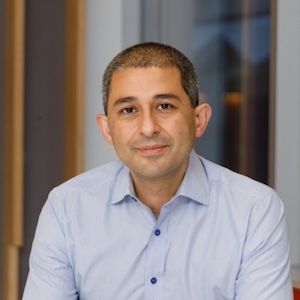News
Article
ARCADIA: Apixaban Not Superior to Aspirin in Reducing Recurrent Stroke Risk
Author(s):
Anticoagulation and antiplatelet therapy show no significant difference in recurrent stroke risk among patients with cryptogenic stroke and evidence of atrial cardiopathy.
Hooman Kamel, MD
Credit: LinkedIn

Results from the ARCADIA randomized clinical trial demonstrated apixaban did not significantly reduce recurrent stroke risk compared with aspirin among patients with cryptogenic stroke and evidence of atrial cardiopathy without atrial fibrillation (AF).1
More than 1000 participants in the multicenter, double-blind, phase 3 clinical trial were randomized to receive apixaban 5 mg or 2 mg twice daily or aspirin (81 mg) once daily. A team of investigators from Weill Cornell Medicine found the annualized rate of recurrent stroke did not significantly differ between the apixaban- and aspirin-treated patients, at 4.4% in both cohorts.
“In patients with a recent cryptogenic stroke and evidence of atrial cardiopathy based on 3 readily available biomarkers, oral anticoagulant therapy with apixaban did not significantly reduce the risk of recurrent stroke compared with aspirin,” wrote the investigative team, led by Hooman Kamel, MD.
Kamel and colleagues set out to compare anticoagulation versus antiplatelet therapy for secondary stroke prevention among a population with cryptogenic stroke and evidence of atrial cardiopathy. The ARCADIA trial involved participants with cryptogenic stroke and evidence of atrial cardiopathy—this was measured as P-wave terminal force ≥5000 µV x ms in electrocardiogram lead VI, serum N-terminal pro-B-type natriuretic peptide ≥250 pg/mL, or left atrial diameter index of ≥3 cm/m2 on echocardiogram.
The included population had no evidence of atrial fibrillation (AF) at the time of randomization. Enrollment and follow-up took place from the beginning to the end of February 2023 at 185 sites in the National Institutes of Health StrokeNet and the Canadian Stroke Consortium. A total of 507 people received apixaban 5 mg or 2.5 mg twice daily and 508 received once-daily aspirin (81 mg) during the study period.
In the time-to-event analysis of the ARCADIA trial, the primary efficacy endpoint was recurrent stroke of any type. Safety outcomes in the analysis were symptomatic intracranial hemorrhage and other major hemorrhage. The entire population, including those diagnosed with AF after trial randomization, was assessed according to their randomization assignment group.
A total of 1015 participants of the 1100 target were enrolled in the study, with a mean follow-up period of 1.8 years. As the hazard ratio (HR) for apixaban versus aspirin lay within the pre-specified interim boundaries for futility, the trial was stopped after the planned interim analysis. Participants had a mean age of 68.0 years, 54.3% were female, and 87.5% completed the full follow-up period.
Upon analysis, the primary outcome of recurrent stroke was identified in 40 patients in the apixaban group (annualized rate, 4.4%) and 40 patients in the aspirin group (annualized rate, 4.4%) (HR,1.00 [95% CI, 0.64 - 1.55]). A post-hoc analysis performed in 149 patients with AF documented after randomization also found no significant difference in the rate of recurrent stroke between apixaban (annualized rate, 1.8%) and aspirin (annualized rate, 2.2%) (HR, 0.84 [95% CI, 0.19 - 3.74]).
Secondary efficacy outcomes of recurrent stroke or death were observed in 67 patients in the apixaban group (annualized rate, 7.3%) and 62 patients in the aspirin group (annualized rate, 6.8%) (HR, 1.08 [95% CI, 0.76 - 1.52]). Safety outcomes showed symptomatic intracranial hemorrhage occurred in zero patients receiving apixaban and in 7 patients receiving aspirin (annualized rate, 1.1%). Other major hemorrhages were identified in 5 patients receiving apixaban (annualized rate, 0.7%) and 5 patients taking aspirin (annualized rate, 0.8%) (HR, 1.02 [95% CI, 0.29 - 3.52]).
An accompanying editorial from Bruce Ovbiagele, MD, MSc, department of neurology, University of California, San Francisco, suggested the ARCADIA trial does not necessarily conclude the ability to treat based on the presence of atrial cardiopathy, independent of AF.2
Although outcome analyses focused on inclusion criteria did not achieve statistically significant results, Ovbiagele noted the point estimates favored protection with apixaban among those selected using P-wave terminal force criterion and harm among those with an elevated NT-proBNP level.
“These data may then suggest that future efforts to identify optimal therapeutic strategies for patients with atrial cardiopathy should focus on markers as directly reflective of left atrial pathology as possible,” Ovbiagele wrote.
References
- Kamel H, Longstreth WT, Tirschwell DL, et al. Apixaban to Prevent Recurrence After Cryptogenic Stroke in Patients With Atrial Cardiopathy: The ARCADIA Randomized Clinical Trial. JAMA. Published online February 07, 2024. doi:10.1001/jama.2023.27188
- Marcus GM, Ovbiagele B. Anticoagulation for Atrial Cardiopathy in Cryptogenic Stroke. JAMA. Published online February 07, 2024. doi:10.1001/jama.2023.23916




